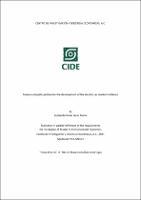| dc.contributor.advisor | Dr. Héctor Mauricio Núñez Amórtegui |
| dc.creator | Jasso Romo, Leobardo Omar |
| dc.date.issued | 2021 |
| dc.identifier | 177813.pdf |
| dc.identifier.uri | http://hdl.handle.net/11651/5774 |
| dc.description.abstract | The electrification of the light transport has the potential to reduce greenhouse gas emissions and improve energy security. This study uses a computable general equilibrium (CGE) model to evaluate the economic and environmental impact of four different scenarios of electric vehicle (EV) adoption. The results show that the high and low penetration scenarios can both reduce GHG emissions with almost no cost or even a small improvement in the overall economy. These scenarios can also deliver benefits to households linked to the light vehicle manufacturing sector. The adoption of EVs can also generate synergies with other ongoing trends such as the rise in generation of clean energy. The worst-case scenario is the low exports scenario, in which no action is taken to adopt EVs and market share is lost in the export market. This scenario does not reduce GHG emissions in the same way as other scenarios and the fall is due to fewer units being produced and not due to better technology. GDP is affected by the reduction of the value-added in the internal combustion engine (ICE) vehicle manufacture sector and this could be reflected in a loss of revenue for all levels of government. The low exports scenario affects the income or employment of households linked to the light vehicle manufacturing sector, which can harm different states disproportionately depending on their exposure to the light vehicle manufacturing industry. Other sectors may see small positive changes due to substituion effects. The status quo scenario is the most unlikely scenario due to current trends of technological changes and national and foreign stated goals. The status quo is the scenario with the greatest GHG emissions due to the high production of ICE vehicles, and it does not help to improve actual gasolina import dependency. Although household income or GDP are not greatly affected in comparison with the low demand scenario, this scenario risks moving to the low exports scenario due to the exogenous nature of the demand of the rest of the world. |
| dc.format | application/PDF |
| dc.language.iso | eng |
| dc.publisher | El Autor |
| dc.rights | Con fundamento en los artículos 21 y 27 de la Ley Federal del Derecho de Autor y como titular de los derechos moral y patrimonial, otorgo de manera gratuita y permanente al Centro de Investigación y Docencia Económicas, A.C. y a su Biblioteca autorización para que fije la obra en cualquier medio, incluido el electrónico, y la divulguen entre sus usuarios, profesores, estudiantes o terceras personas, sin que pueda percibir por tal divulgación una contraprestación. |
| dc.subject.lcsh | Greenhouse gas mitigation -- Effect of electric vehicles on -- Mexico -- Mathematical models. |
| dc.subject.lcsh | Energy security -- Effect of electric vehicles on -- Mexico -- Mathematical models. |
| dc.subject.lcsh | Electric vehicles -- Environmental aspects. |
| dc.title | Analysis of public policies for the development of the electric car market in Mexico |
| dc.type | Tesis de maestría |
| dc.accessrights | Acceso abierto |
| dc.recordIdentifier | 000177813 |
| dc.rights.license | Creative Commons Reconocimiento-NoComercial-SinObraDerivada 4.0 Internacional CC BY-NC-ND |
| thesis.degree.grantor | Centro de Investigación y Docencia Económicas |
| thesis.degree.name | Maestría en Economía Ambiental |
| dc.proquest.rights | Yes |


